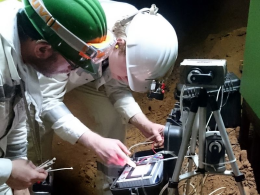Determining the equilibrium factor for radon based dose management
With respect to the new radiation protection law, a continuous monitoring with dose management must be established for workplaces where the radon concentration permanently exceeds the legal reference level.
Not the radon gas itself represents the risk for health but its radioactive daughter products which are generated in the breathing air due to the radon decay process. These daughters will be accumulated in the lung where they release their alpha energy directly in the tissue. Therefore, an equivalent dose can only derived from the activity concentration of the radon daughter products.
Due to practical considerations, the daughter product concentration is usually estimated by measurements of radon gas. This requires the knowledge of the equilibrium factor F which describes the ration between radon daughter product (EEC) and radon gas concentration. The equilibrium factor F is defined for a range between zero (no radon daughters in the air) and one (all generated radon daughters remain in the air—radioactive equilibrium of the entire decay chain). The real value of F depends strongly on the local conditions like ventilation, aerosol concentration, size of the room and the kind of usage. A wrong presumption of F will result in a systematic under- or overestimation of the dose. Therefore it is required to derive a characteristic F value for such workplaces by representative measurements meaning simultaneous sampling of radon gas and daughter products over longer periods.
The instruments EQF3200 and EQF3220 have been developed to perform such measurements. Both instruments contain a radon measurement chamber as well as a filter/detector combination to determine the daughter product concentration. The construction ensures that both channels are taking measuring values of the same sample of air.
The open-face sampling head avoids deposition of daughter products at surfaces or inside tubes before the air passes the filter. There is no interference by thoron and its progeny due to the spectroscopic analysis.
In addition, the EQF3220 distinguishes between the two particle-size fractions of interest. Atoms or clusters smaller than 100 nanometer are generally called the unattached fraction whilst the attached fraction is created by deposition of daughter products at the surface of aerosols already present in the air. This fraction has typically diameters of around one micrometer. Because only the attached fraction can enter the lung, a large unidentified portion of unattached daughter products would result in an overestimation of the dose.



